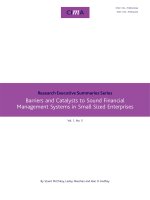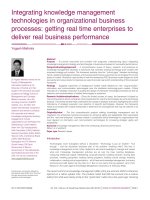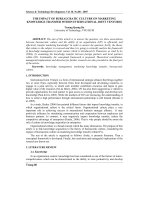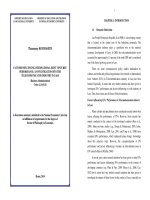Management controls in automotive international joint ventures involving Chinese parent companies
Bạn đang xem bản rút gọn của tài liệu. Xem và tải ngay bản đầy đủ của tài liệu tại đây (427.04 KB, 8 trang )
Management controls in automotive
international joint ventures involving
Chinese parent companies
Research executive summary series
Volume 7 | Issue 9
Guliang Tang
University of
International Business
and Economics, PRC
Hiroshi Okano
Osaka City University,
Japan
Chen Gao
Beijing Technology and
Business University, PRC
Pingli Li
Middlesex University
Business School, UK
Key findings:
• Flexibility in international joint ventures (IJVs) is important and a shared but split
control style is recommended.
• Chinese partners used to have learning as their main objective in an IJV but this
has been replaced by profit, growth and market share.
• The most significant shifts in control between partners involve human resource
management and research and development.
• When foreign partners insist on adherence to their own management philosophy,
culture clashes occur.
• Negotiation is a part of daily life in the IJVs, and it occurs at both executive and
managerial levels, depending upon the significance of the item.
1 | Management controls in automotive international joint ventures involving Chinese parent companies
Overview and objectives
This project investigated the management controls exerted by
overseas and local parents in four automotive international joint
ventures (IJVs) in China. A shared but split management style
was identified, which supplements the previous studies on IJVs
management. The study also found evidence on the dynamics of
management controls and the drivers behind change.
Over time, IJVs have become common in a wide range of
industries due to rapid technological changes and increased
emphasis on globalisation strategies. The emergence of China
as the ’factory to the world’ and its rapidly growing domestic
market are attractive to investors. For example, in 2009 China
sold 13.5 million vehicles and became the largest car market
overtaking the United States who sold 10.4 million in 2009.
Established ‘old world’ firms cannot ignore these markets if they
want to maintain pre-eminence in mass markets.
Cultural pressures, government imposed controls and the costs
of setting up new operations in far away markets means that
partnerships with local firms are often the most sensible, or only
form of business development. This often occurs if the overseas
firm wants to be an integral part of the local economy and
not simply an importer. Consequently, China has become the
world’s largest recipient of foreign direct investment today, and
IJVs between overseas and Chinese companies have become
one of the predominant modes of entry into China. From 1982
to 2004, China experienced an average annual growth rate of
24% in foreign investment and almost 32% in equity IJVs. In
the automotive industry, IJV is the only available mode because
the Chinese government does not allow wholly foreign owned
enterprises and requires that Chinese partners hold at least 50%
equity in IJVs.
While there are more opportunities for multi-national
enterprises to realise their objectives in China, the control of
IJVs is very challenging. Previous studies suggest difficulties in
managing IJVs involving Chinese partners and management
controls have been identified as one of the factors that influence
the performance of IJVs (e.g. Geringer and Hebert, 1989; Chalos
and O’Connor, 2005). In order to effectively exert management
controls, it is important to understand how such controls have
been applied in practice.
This study adopts a bargaining power model to examine what
and how management controls have been exerted by overseas
and local parents, and how these have been shaped by the
relative bargaining power of parents. The bargaining power
model has been used to explain how a parent can use its
resources and capabilities to gain control of its IJV to ensure
the best possible return from the investment on the IJV. It also
explains how to protect its strategic resources – like intellectual
property – against industrial espionage (Yan and Gray, 1994).
The previous studies of applying this model focus on the IJV
formation stage and take the perspective that management
controls are affected and determined at an IJV formation stage.
We know little about how managers from different parents co-
operate and compete simultaneously in the control process.
Aiming to close some of the above research gaps, the present
study conducted four case studies and attempted to address the
following two research questions:
1. What management control mechanisms have been exerted
in the case companies, and how?
2. How do management controls evolve and what are the
drivers behind change?
Findings
The general background of these companies can be outlined as
below:
• All are automotive IJVs in China, involving one European; one
Japanese; and one Korean overseas company.
• The Chinese companies involved are state-owned and located
in four different regions.
• All have 50/50 shareholdings between overseas and local
partners.
• All could be regarded as successful, based on two criteria:
− certain operation periods (six to eight years) and survival
to date.
− reported executive satisfaction with the achievement of
objectives.
The control mechanisms adopted by both parents
There are a variety of control mechanisms a partner may
adopt in the control of its IJV. From our observation, the main
mechanisms used by the overseas partners are:
• staffing
• adopting similar production and management systems
• mentoring and training.
Those used by the local partners are:
• staffing
• budgeting.
Although the overseas partners participated in budgeting, they
used it mainly as a tool for planning, rather than as a control
mechanism.
2 | Management controls in automotive international joint ventures involving Chinese parent companies
Shared but split control style
The study identified the control model of the IJVs as ‘shared, but
split
1
’, as depicted in Figure 1.
Control access to the entire range of activities: share
control
Based on 50/50 shareholdings, the overseas and local partners
hold the same number of seats on the board of directors. All
decisions in the case companies are made by consensus and no
partner can be outvoted. This governance structure allows both
parents to share control over the entire range of activities.
This finding is consistent with previous studies on the control
focus from overseas partners, but inconsistent with the local
side. The Chinese partners used to focus their control only on
specific areas and did not have motivation for overall control, as
identified by prior studies. In our case companies, the Chinese
partners have shown a strong desire for overall control and
have actually obtained the control access to the entire range
of activities. From our observation, this change might be the
result of their shifted objectives. Chinese companies used to
have learning as their main objective in IJVs, but our case studies
show their three most important objectives to be profit, growth
and market share.
Tight control over specific areas: split control
A partner’s control can be regarded as tight when there exists
a high degree of certainty that decisions will be made as that
partner wishes. While the overseas and local parents have the
same control access to the entire range of activities, it does not
mean that they have the equal control tightness in all areas.
Partner control tightness in particular areas is linked to their
resource contributions, as observed from the case studies.
The resources contributed by both parents – apart from financial
investment – are not even. From our investigation, the most
important resources contributed by the overseas parents are:
• manufacturing techniques
• operation management systems
• supplier networks
• distribution of products
• product brands.
Contributions of the local parents are:
• local market knowledge
• government resource input and policy support
• expertise in local human resources management .
1 Previous studies on the control of IJVs identified four control styles as ‘shared, dominant, independent, and split’. For detailed explanation of these styles,
refer to Geringer and Hebert, 1989; Killing, 1983.
Board of directors
Overseas partner
Local partner
Operation management committee
Introducing
new products
Human resources
management
Manufacturing
planning
Cost
management
Quality
control
Government
relationship
Pricing
Procurement Budgeting
Function managers
Figure 1. Shared but split management style and its dynamics
Control from non-Chinese partners
Control from Chinese partners
Increased control from the Chinese partners
Heavier weight of the lines: tighter control
+++
+++
+++
+++
+++
+++
+++
3 | Management controls in automotive international joint ventures involving Chinese parent companies
A shared control style allows both parents to exert overall
control, however the same extent of control tightness across
all areas from two parents might result in inefficiency and
increased managerial difficulty. Rationally, both parents choose
‘shared but split control’ – they only exert tight control over
the areas in which they possess technology and knowledge. In
the case study companies, the overseas partners exert tighter
control over introducing new products, procurement, cost
management and quality control. The local partners exerted
tighter control over the areas of human resource management,
government relationship, and they share a balanced control over
manufacturing planning, pricing, and budgeting, as shown by the
thickness in the lines in Figure 1.
Benefits of adopting a shared but split control model
While the importance of local markets and government policies
in certain industries award local companies with greater
bargaining power, shared management is increasingly preferred
by local parents. This is contrary to the findings of previous
studies. Overseas company dominant management might
also be undesirable for foreign parents because it potentially
hampers IJVs benefiting from the knowledge and management
expertise of local parents. A ‘shared but split’ management style
reflects the strategic positions of both parents, provides them
with control access to the entire range of activities, and offers
them the opportunities to play out their strengths that are
important for the success of an IJV.
The dynamics
Although there is no evidence of significant changes in the
corporate governance structure in the case companies, the
study found that control tightness in some areas has shifted
between the partners during the operation of the IJVs. The
most significant changes are in the areas of human resource
management (HRM) and research and development (R&D).
Increased control tightness on HRM from the local
parents
Because of their strength in technology and management,
the overseas partners initially pursued tight control in all
areas, including HRM. This caused various problems in the
management of those IJVs. For example, a Japanese IJV did not
apply punishment to workers at the beginning of its operation
based on its culture of loyalty through ’life-long employment’.
This did not prove a good fit with the Chinese culture, and
this IJV has changed to a policy of combining appraisal and
punishment, which is commonly applied in local companies.
Similar changes occurred in all the case companies, although to
a differing extent.
Increased local parent influence on design and
marketing of new products
When overseas parents insist on adhering to their own
management philosophy, they encounter a culture clash. For
example, an overseas parent was not completely satisfied with
their performance in the Chinese market in terms of market
share. They identified the main reason as their marketing
strategy not fitting well into the Chinese culture. ‘We should put
more efforts on understanding China, understanding how local
people think,’ reflects an overseas Financial Manager in this IJV.
As a consequence of this reflection, this IJV established an R&D
department in 2008.
The two IJVs we studied recently established their R&D
departments, and a third has announced a plan to establish
a joint R&D institute in late 2011. Overall, the opinions of
local parents and managers on introducing new models are
taken more seriously, and decisions are made more locally, as
evidenced in all case IJVs.
In general, we observed increased influence from the
local partners over the areas of introducing new products,
manufacturing planning, pricing, quality control, budgeting, and
their dominant control over HRM in all case IJVs, as shown in
Figure 1. The extent of these changes varied across the firms.
The acceptance of the shifted control tightness from both
overseas and local parents provides empirical evidence that
IJVs need to reconfigure over time in response to changes in
the partners’ relative bargaining power to ensure stability and
overall performance (e.g. Yan & Gray, 1992). The shared and split
control style fitted well with this dynamic environment.
The factors promoting the changes
The drivers behind the control dynamics are identified as below:
• The acknowledgement of cultural differences from the
overseas companies.
• The increased importance of the Chinese market in the
globalised world.
• The influence of local government, as further discussed below.
The role of local government
Because of the economic significance of the automotive
industry and that local partners were state-owned, local
government plays a significant role in China at the IJV formation
and operation stages. The present study reveals that while the
involvement of local government brings vital resources and
support to an IJV, it also adds uncertainty. This is one of the
factors contributing to the control dynamics.
4 | Management controls in automotive international joint ventures involving Chinese parent companies
Our study identified the following ways in which local
government affects IJVs.
• At the formation stage, the resources and support provided
by local government are an important consideration for the
overseas partners, as observed in all case companies.
• Local government’s political needs may affect management
control at the formation and operation stage.
− Overseas partners may win favourable deals by taking
advantage of the urgent political needs of a local
government. Such needs may include having more IJVs in
a certain area, improving the performance of state-owned
firms, and rapidly increasing industry size.
− Overseas partners may have to compromise later. For
example, local government may add extra conditions to
an approval request relating to certain activities during
the operation of an IJV. An important motivator for one
of the case companies to set up an R&D department was
a precondition the local government set when the IJV
requested its approval for building a new factory.
Bargaining in control process
Bargaining during the operation process is observed in all four
case companies, although the level of intensity differs. This
brings the elements of support and challenge from two parents
into the relationship between the managers. ’We are in the
meetings most of the time’ – all managers we interviewed made
this comment on their experience. Furthermore, they ranked the
improved negotiating ability as their most important work-
based learning outcome.
The case studies reveal both partners take profit, growth and
market share as their most important objectives. However,
they prioritise differently, especially in the first few years – the
overseas partners’ primary objective is local market share, while
the Chinese partners do not want to sacrifice profit for growth.
This gap is caused largely by the un-equal number of profit
sources from and un-even control over the profitability of IJVs
between partners.
First, the profit pool available to the overseas partner of an IJV
may be larger than the IJV itself. For a local partner, distributed
profit is the main financial income from its IJV. In comparison,
overseas partners have many other ways to benefit financially
from the IJVs because of their contribution of technology and
supplier networks. These profit sources include equipment sales,
technology transfer fees, related transactions with suppliers, and
other inter-organisational transactions. In one case company, the
local managers once analysed and identified 18-20 sources from
which the overseas partner could profit from this joint venture,
in addition to the distributed profit. Moreover, for an overseas
partner, the establishment of an IJV also enhances its business
development in other areas in China.
Second, the tighter control on transfer pricing and new product
introduction from overseas partners has further increased
the extent of their control over IJV profitability. While the
parents share the profit 50/50 – as determined by the equity
shareholding – the total amount of annual profit is significantly
affected by the negotiation of transfer prices and product
portfolio decisions. When the principles of setting transfer prices
have been negotiated in the formation stage of an IJV and
stated in the contract, the specific figures for each year vary
depending on the items for transfer.
Circumstances make negotiation a part of daily life in the IJVs:
• less profitability-focus due to the number of profit sources
with stronger control over IJV profitability for overseas
partners
• stronger desire for profit but a weaker position in profit
control for local partners.
Negotiation occurs at both executive and managerial levels,
depending upon the significance of the item.
Implications for investors and managers
The shared but split control style: model with
flexibility and fitting well into dynamic environments
Being successful in China has never been more important to
multi-national enterprises because of the enormous size and
the developing speed of Chinese markets. While this strong
market provides more opportunities for overseas companies,
it also awards local companies stronger bargaining power.
Together with shifting objectives from learning to profitability
and growth, we should not be surprised by local companies’
desire to be actively involved in the control of the entire range
of activities within IJVs. Keeping the flexibility in control will
enhance the cooperation between overseas and local parents,
reduce the managing difficulty, and eventually bring mutual
benefits. The shared but split control style we identified from the
case studies is an example of such flexible models.
Be aware of the different roles that may be played by
local government
The interference of local government in China occurs at the
formation and operation stages, and could bring benefit or
challenge into IJVs. It is important for the invertors to be aware
of the nature of the interference and be prepared to deal with it,
either taking advantage or compromising.
5 | Management controls in automotive international joint ventures involving Chinese parent companies
Prepare expatriates with negotiating skills
For the managers in an IJV, negotiation is a part of their daily
life. Parent companies and managers should realise that
negotiation exists not only at the formation stage and board
level, but also at the operational stage and at executive and
managerial levels. Preparing managers with good negotiating
skills is important not just for the success of any IJV, but also for
the well-being of those managers involved.
Conclusion
The present study provided the first observation on evolutionary
changes in the extent of controls exerted by parents in their IJVs.
The factors promoting changes were identified as culture clash,
rapid market changes and the roles played by local government.
The influences of these multiple forces in the control process
increase the difficulty in managing IJVs in China. Our study
recognised the importance of keeping flexibility in managing
IJVs in China and identified such a flexible model as a shared
but split control style. Our research found that managers clearly
have a role to play in the effectiveness of controls in IJVs.
Management controls have not just been determined at the
formation stage of an IJV, but also shaped by the negotiation
and changing bargaining power during the operation.
Acknowledgements
Researchers would like to thank CIMA’s general charitable trust
for funding this project. We are also grateful to Professor Chris
Chapman, Professor Franz Waldenberger, Professor Tae Sik
Ahnand and the interviewees involved for their kind support
during the research process.
References and further readings
Chalos, P., O’Conner, N. G. (2004) Determinants of the use
of various control mechanisms in US-Chinese joint ventures
Accounting, Organisations and Society, 29, 591-608.
Geringer, J. M. & Hebert, L. (1989) Control and performance of
international joint ventures, Journal of International Business
Studies, 20(2), 235-254.
Groot, L. C. M. & Merchant, K. A. (2000) Control of international
joint ventures, Accounting, Organisations and Society, 25, 579-
607.
Killing, J. P. (1983) Strategies for joint venture success, Kent:
Croom Helm.
Yan, A. & Gray, B. (1994) Bargaining power, management
control, and performance in United States-China joint ventures: a
comparative case study, Academy of Management Journal, 37(6)
1478-1517.
Pingli Li
E.
Guliang Tang
E.
Hiroshi Okano
E.
Chen Gao
E.
ISSN 1744-702X (print)
Chartered Institute of
Management Accountants
26 Chapter Street
London SW1P 4NP
United Kingdom
T. +44 (0)20 7663 5441
E.
www.cimaglobal.com
© July 2011, Chartered Institute of Management Accountants









